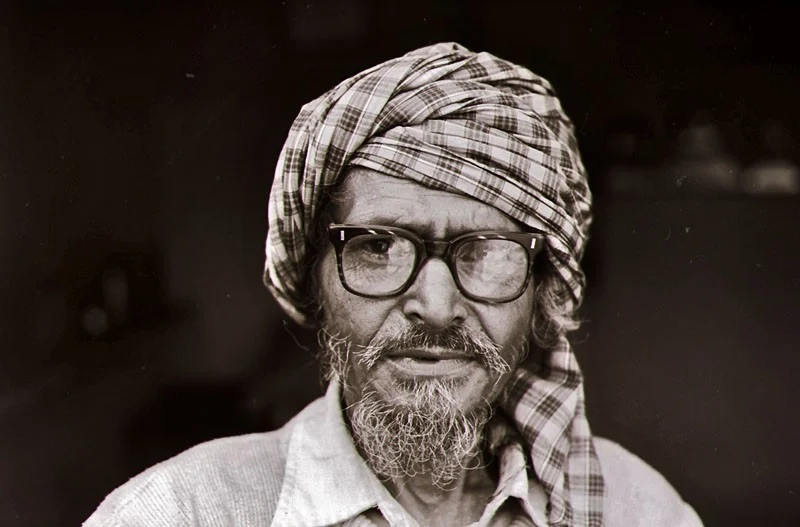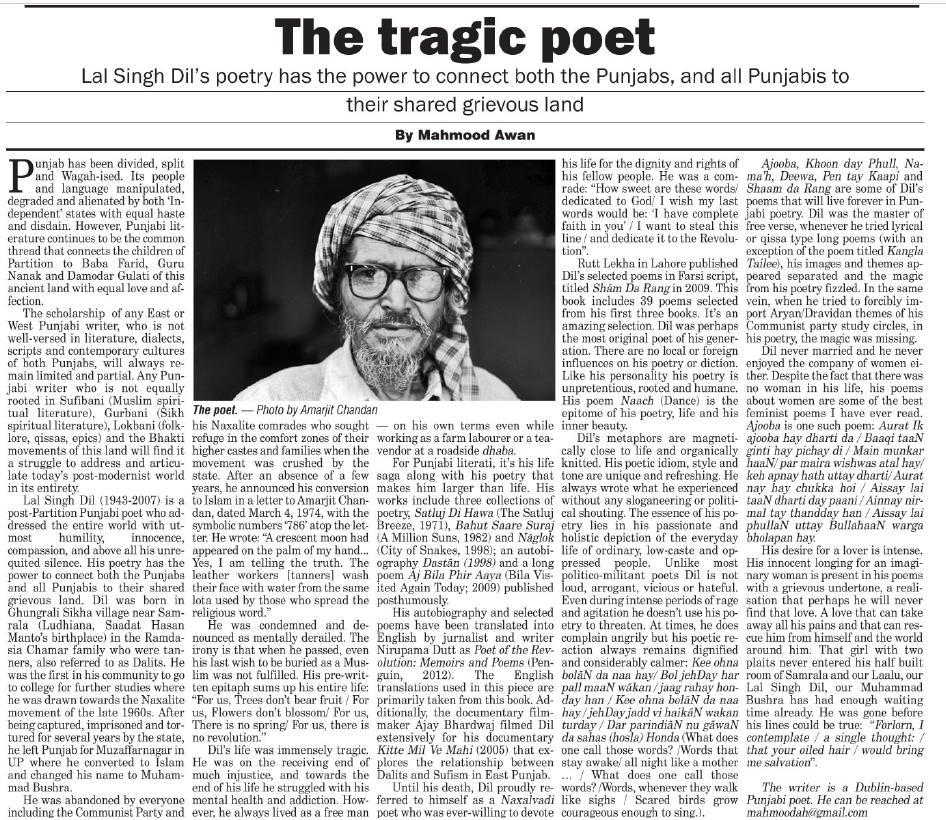Mahmood Awan (The News on Sunday, 17th July 2016)
Punjab has been divided, split and Wagah-ised. Its people and language manipulated, degraded and alienated by both ‘Independent’ states with equal haste and disdain. However, Punjabi literature continues to be the common thread that connects the children of Partition to Baba Farid, Guru Nanak and Damodar Gulati of this ancient land with equal love and affection.
The scholarship of any East or West Punjabi writer, who is not well-versed in literature, dialects, scripts and contemporary cultures of both Punjabs, will always remain limited and partial. Any Punjabi writer who is not equally rooted in Sufibani (Muslim spiritual literature), Gurbani (Sikh spiritual literature), Lokbani (folklore, qissas, epics) and the Bhakti movements of this land will find it a struggle to address and articulate today’s post-modernist world in its entirety.
Lal Singh Dil (1943-2007) is a post-Partition Punjabi poet who addressed the entire world with utmost humility, innocence, compassion, and above all his unrequited silence. His poetry has the power to connect both the Punjabs and all Punjabis to their shared grievous land. Dil was born in Ghungrali Sikha village near Samrala (Ludhiana, Saadat Hasan Manto’s birthplace) in the Ramdasia Chamar family who were tanners, also referred to as Dalits. He was the first in his community to go to college for further studies where he was drawn towards the Naxalite movement of the late 1960s. After being captured, imprisoned and tortured for several years by the state, he left Punjab for Muzaffarnagar in UP where he converted to Islam and changed his name to Muhammad Bushra.
He was abandoned by everyone including the Communist Party and his Naxalite comrades who sought refuge in the comfort zones of their higher castes and families when the movement was crushed by the state. After an absence of a few years, he announced his conversion to Islam in a letter to Amarjit Chandan, dated March 4, 1974, with the symbolic numbers ‘786’ atop the letter. He wrote: “A crescent moon had appeared on the palm of my hand… Yes, I am telling the truth. The leather workers [tanners] wash their face with water from the same lota used by those who spread the religious word.”
He was condemned and denounced as mentally derailed. The irony is that when he passed, even his last wish to be buried as a Muslim was not fulfilled. His pre-written epitaph sums up his entire life: “For us, Trees don’t bear fruit / For us, Flowers don’t blossom/ For us, There is no spring/ For us, there is no revolution.”
Dil’s life was immensely tragic. He was on the receiving end of much injustice, and towards the end of his life he struggled with his mental health and addiction. However, he always lived as a free man — on his own terms even while working as a farm labourer or a tea-vendor at a roadside dhaba.
For Punjabi literati, it’s his life saga along with his poetry that makes him larger than life. His works include three collections of poetry, Satluj Di Hawa (The Satluj Breeze, 1971), Bahut Saare Suraj (A Million Suns, 1982) and Nãglok (City of Snakes, 1998); an autobiography Dastãn (1998) and a long poem Aj Bila Phir Aaya (Bila Visited Again Today; 2009) published posthumously.
His autobiography and selected poems have been translated into English by jurnalist and writer Nirupama Dutt as Poet of the Revolution: Memoirs and Poems (Penguin, 2012). The English translations used in this piece are primarily taken from this book. Additionally, the documentary filmmaker Ajay Bhardwaj filmed Dil extensively for his documentary Kitte Mil Ve Mahi (2005) that explores the relationship between Dalits and Sufism in East Punjab.
Until his death, Dil proudly referred to himself as a Naxalvadi poet who was ever-willing to devote his life for the dignity and rights of his fellow people. He was a comrade: “How sweet are these words/ dedicated to God/ I wish my last words would be: ‘I have complete faith in you’ / I want to steal this line / and dedicate it to the Revolution”.
Kitab Trinjan in Lahore published Dil’s selected poems in Farsi script, titled Shãm Da Rang in 2009. This book includes 39 poems selected from his first three books. It’s an amazing selection. Dil was perhaps the most original poet of his generation. There are no local or foreign influences on his poetry or diction. Like his personality his poetry is unpretentious, rooted and humane. His poem Naach (Dance) is the epitome of his poetry, life and his inner beauty.
Dil’s metaphors are magnetically close to life and organically knitted. His poetic idiom, style and tone is unique and refreshing. He always wrote what he experienced without any sloganeering or political shouting. The essence of his poetry lies in his passionate and holistic depiction of the everyday life of ordinary, low-caste and oppressed people. Unlike most politico-militant poets Dil is not loud, arrogant, vicious or hateful. Even during intense periods of rage and agitation he doesn’t use his poetry to threaten. At times, he does complain angrily but his poetic reaction always remains dignified and considerably calmer: Kee ohna bolãN da naa hay/ Bol jehDay har pall maaN wãkan / jaag rahay honday han / Kee ohna bolãN da naa hay / jehDay jadd vi haikãN wakan turday / Dar parindiãN nu gãwaN da sahas (hosla) Honda (What does one call those words? /Words that stay awake/ all night like a mother … / What does one call those words? /Words, whenever they walk like sighs / Scared birds grow courageous enough to sing.).
Ajooba, Khoon day Phull, Nama’h, Deewa, Pen tay Kaapi and Shaam da Rang are some of Dil’s poems that will live forever in Punjabi poetry. Dil was the master of free verse, whenever he tried lyrical or qissa type long poems (with an exception of the poem titled Kangla Tailee), his images and themes appeared separated and the magic from his poetry fizzled. In the same vein, when he tried to forcibly import Aryan/Dravidan themes of his Communist party study circles, in his poetry, the magic was missing.
Dil never married and he never enjoyed the company of women either. Despite the fact that there was no woman in his life, his poems about women are some of the best feminist poems I have ever read. Ajooba is one such poem: Aurat Ik ajooba hay dharti da / Baaqi taaN ginti hay pichay di / Main munkar haaN/ par maira wishwas atal hay/ keh apnay hath uttay dharti/ Aurat nay hay chukka hoi / Aissay lai taaN dharti day paani / Ainnay nirmal tay thandday han / Aissay lai phullaN uttay BullahaaN warga bholapan hay.
His desire for a lover is intense. His innocent longing for an imaginary woman is present in his poems with a grievous undertone, a realisation that perhaps he will never find that love. A love that can take away all his pains and that can rescue him from himself and the world around him. That girl with two plaits never entered his half built room of Samrala and our Laalu, our Lal Singh Dil, our Muhammad Bushra has had enough waiting time already. He was gone before his lines could be true: “Forlorn, I contemplate / a single thought: / that your oiled hair / would bring me salvation“.
Published on 17th July 2016 in The News on Sunday.
https://www.thenews.com.pk/tns/detail/561356-tragic-poet


